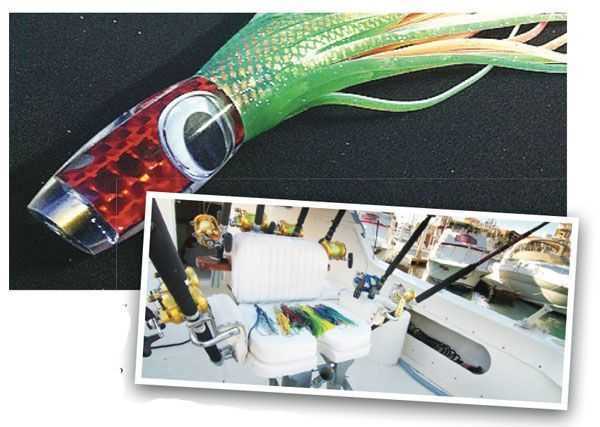There is something magical about a lure that works—old and trusty, always produces a fish when others cannot buy a bite. On some days there seems to be no rhyme or reason why one lure is crushed time and time again on a fishing trip, the skirts shredded, the head chipped and broken, the hooks all bent out of whack—but it still gets the hit!
So what is important when it comes to lures? Color? Size? Shape? How it’s rigged? Where it’s in the spread? Speed? Leader choice? Action? Weight and balance? Texture? Workmanship? Cost?
The answer is that they are all important.
The most common two criteria anglers consider when buying a new lure are color and cost. Color invariably is the first consideration. With the veritable rainbow of choices hanging on the wall of the tackle store, it’s the most obvious variable to consider. But is that the right approach? Color is the least important consideration.
COLOR IS THE LEAST IMPORTANT CONSIDERATION.
Whaaaaaaaat? No way, my—insert your favorite color here—colored lure always catches more fish than any other, and my—insert your least favorite—colored lure never works. Pretty much everyone reading this article will insert a different color combo in each slot and they will think they are right, and they are. Anglers use the colors they catch most fish on, so they catch more fish on that color, so it must be the best color, right?
What they are really doing is using the best lure in the best way. If they used another color in the same way it would work just as well. The point is that a good, well-made lure run right can be of any hue and will out-fish a favorite-colored lure run poorly. After all, the whole idea is to trick a fish into thinking it is looking at a baitfish suitable to chase down and eat. If the artificial bait does not swim right or look enticing the game fish will not attack it. No matter what color it is.
Cost should also not be of such concern. Compared to the cost of the boat and fishing trip, it is negligible. Same goes for terminal tackle, too. If lures are rigged properly and fish are fought with care the loss rate will be very low. There is plenty that can be done to mitigate the chances of losing that $60 lure.
Workmanship—do the skirts fit properly? Are there sharp ridges and obvious burrs resulting from sloppy molding? Look down on the lure from on top. Is the insert aligned with the face of the lure, or is it tilting? If a lure just clearly does not look like it was built with care and attention then it wasn’t, and there is no reason to think it will run very well either. You get what you pay for. Weight and balance is important, too. This costs money and time to do but it can make an enormous difference in how the lure behaves in the water. A lure with no weight will have a very difficult time diving down and popping again, except in the most favorable conditions.
The ultimate way to weight a lure is to have the entire load in the bottom half of the head; this is called keel weighting and is very difficult to do. Keel weighted lures will have all the ballast weight suspended, precisely centered, below the central leader tube. This gives the lure incredible stability and makes it look that more lifelike with the eyes to the side at all times. The other benefit is having the hooks oriented correctly. They may be aligned outboard left or right, depending on which side of the boat the lure is positioned, maximizing hook-up chances on a fish coming into the spread from the outside. Money well spent if you can find a keeled lure!
Shape, speed, leader choice and rigging all have a direct affect on how any given lure behaves in the water. Make sure the leader is not so big and stiff it overcomes and dampens the action of the lure; likewise don’t add hooks so big they drag it down. Speed will greatly affect how lures swim and pop, and trial and error at sea will quickly indicate problems. Remember, if the motion doesn’t look right in the water it will not elicit a strike.
Texture is something some hold dear and others not so much. Hard-headed resin lures work just fine, as do the soft-headed molded lures. Craftsmanship is really what is important.
Size matters. No, it doesn’t. Big fish hit small lures and small fish hit big lures. However, there is no doubt that the bigger the lure the bigger the fish rule will win out in the long run. What is truly surprising is the number of relatively average size fish that will be caught on lures more than a foot long and intended for much larger pelagics. Catching peanut dorado on big marlin lures is not uncommon at all, and when it happens marvel at the ambition of such a small fish attacking a relatively large prey.
In conclusion, choose a well-constructed and balanced lure suitable for the sea conditions and target species, rig it and run it properly and results will be sure to follow—no matter what color it is!
